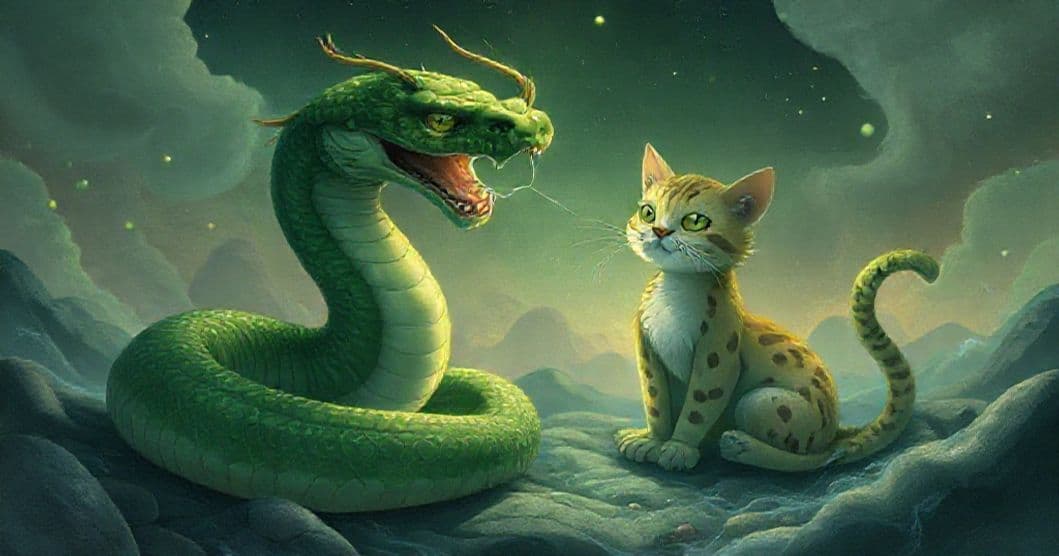The Green Serpent and the Tubby Cat: Dream Symbolism of Protection and Transformation
Part 1: Dream Presentation
Dreams often serve as mirrors reflecting our inner conflicts and unacknowledged emotions. This particular dream, with its vivid imagery of a green snake and a beloved old cat, offers a compelling narrative rich with symbolic potential. In the dream, the dreamer finds themselves in their current living situation, having adopted a small green snake as a pet. Initially, the snake is charming and gentle—its bites are playful, almost affectionate, suggesting a new connection or responsibility that feels nurturing and manageable. However, the dream takes a dramatic turn: the snake transforms into an aggressive pursuer, biting more forcefully and chasing the dreamer throughout the home. Desperate for help, the dreamer calls upon their deceased cat, Tubby, who appears to protectively attack the snake, ultimately decapitating it. The dream ends with a mix of relief and discomfort, leaving the dreamer to ponder its meaning in the context of their waking life.
Part 2: Clinical Analysis
Symbolic Landscape: The Snake as a Transformative Force
Want a More Personalized Interpretation?
Get your own AI-powered dream analysis tailored specifically to your dream
🔮Try Dream Analysis FreeThe green snake emerges as a central symbol, embodying dualities that often appear in dreams: nurturing and threat, curiosity and danger. In many mythologies and psychological frameworks, snakes represent transformation, healing, and the unconscious mind’s creative power. Here, the snake’s initial “cuteness” and gentle nature may symbolize a new project, relationship, or responsibility that begins with optimism and care. The snake’s color—green—additionally evokes themes of growth, renewal, and emotional balance. However, its shift to aggression introduces a critical tension: what started as a nurturing experience has evolved into something threatening, possibly reflecting a situation in waking life that has become overwhelming or unmanageable.
The snake’s bites—first playful, then painful—suggest boundary issues. The initial “tap” could represent minor intrusions or试探性的 interactions that feel harmless, while the later, more forceful bites signify crossed boundaries or escalating challenges. This transformation mirrors how we sometimes project our fears onto situations that initially seemed manageable, or how relationships (or responsibilities) can shift unexpectedly, triggering anxiety or defensiveness.
Psychological Undercurrents: Jungian and Freudian Perspectives
From a Jungian perspective, the snake may represent the shadow self—the aspects of ourselves we avoid or repress. Its dual nature (gentle companion vs. aggressive pursuer) suggests the shadow is emerging, demanding attention. The snake’s pursuit could symbolize unresolved emotions or fears that have been “adopted” or taken on, now asserting themselves as unacknowledged pressures. Tubby, the deceased cat, embodies the anima/animus archetype or the wise old woman/man—a nurturing, protective figure from the collective unconscious. Her unexpected appearance in the dream (the dreamer’s “old cat,” no longer present in waking life) signals a longing for past safety, comfort, or a version of themselves that felt more secure.
Freud might interpret the snake as a repressed sexual or aggressive impulse, with the bite symbolizing the expression of these repressed feelings. However, the dream’s focus on relationship dynamics (adopting a pet, caring for it, then being threatened) leans more toward object relations theory, where the snake represents a relationship that has become pathogenic or unbalanced. The decapitation could symbolize an attempt to sever harmful connections, though the “sick” feeling afterward suggests this resolution carries emotional weight.
Emotional and Life Context: Navigating Change and Boundaries
The dreamer mentions their “current living situation and flatmates,” suggesting external changes or relationship dynamics may be triggering internal tensions. The snake’s transformation from a pet to a pursuer could reflect a new responsibility (like a project, relationship, or living arrangement) that initially felt exciting but has become overwhelming. Tubby’s role as the protector hints at nostalgia for a time when challenges were managed with more ease or comfort, or a need to reconnect with protective inner resources now missing in waking life.
The kitchen setting—where the confrontation occurs—represents a space of sustenance and preparation, suggesting the dream is processing how to “feed” or address needs in a healthy way. The snake’s persistence in the dream mirrors how unresolved issues can feel inescapable, even when we try to avoid them. The decapitation, while violent, offers a resolution to the threat, but the “sick” feeling afterward indicates that eliminating a problem (or a person) isn’t always emotionally clean or easy.
Therapeutic Insights: Reflecting on Unconscious Messages
This dream invites the dreamer to examine areas where boundaries are being tested or where relationships have become unbalanced. Consider journaling about current responsibilities or relationships that feel like they’re “chasing” you, and whether they’re truly nurturing or becoming draining. The appearance of Tubby suggests reconnecting with past sources of comfort or strength—perhaps revisiting old hobbies, routines, or relationships that provided security.
Reflective questions: Where in my life do I feel “chased” by responsibilities or relationships? What boundaries need to be set to prevent nurturing connections from turning threatening? How can I honor the protective parts of myself (like Tubby) without becoming overly dependent on the past? Practical steps might include creating clearer boundaries in current relationships, practicing mindfulness to recognize when stressors are becoming overwhelming, and engaging in activities that foster self-care and emotional resilience.
FAQ Section
Q: What does it mean when the snake starts as a cute pet and then becomes aggressive?
A: This shift often reflects how a new responsibility or relationship can evolve from nurturing to overwhelming. It may signal boundary issues or unmet expectations in waking life.
Q: Why is the old cat important in this dream?
A: The cat represents protective inner resources or nostalgia for safety. Its appearance suggests a need to reconnect with comforting routines, values, or support systems.
Q: How should I interpret the relief mixed with feeling sick after decapitation?
A: Relief comes from resolving a threat, while “sickness” acknowledges the emotional cost of eliminating a problem. It suggests the need to process closure with care, not just urgency.
